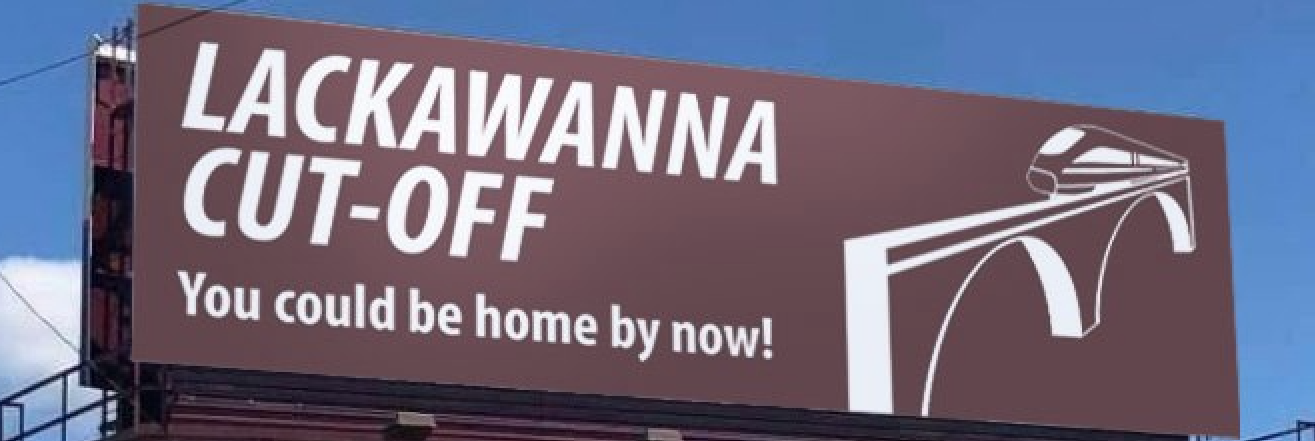The first revenue train to operate on the Cut-Off under the new timetable that went into effect at 2:00 a.m. on Sunday, December 24, 1911, was Train No. 15, a westbound passenger train, the Chicago Mail, that was scheduled to pass through Port Morris Junction at about 3:36 a.m. Most long-distance trains that traversed the Old Road shifted to the Cut-Off, effectively downgrading the older line to secondary status.
The Cut-Off was built to permit unrestricted speeds for passenger trains of 70 mph (110 km/h) (heavier rail that was installed later allowed speeds to increase to 80 mph (130 km/h)), although trains that were late were known to occasionally exceed the speed limit to “make up time.” Mile-long eastbound and westbound sidings were built at Slateford (east of the junction), Hainesburg (west of the viaduct), Johnsonburg (west of the station), Roseville (about two miles east of the tunnel), and Port Morris (west of the junction. An elaborate four-mile (6.4 km) long section of three tracks at Greendell, controlled by the Greendell interlocking tower, allowed for greater operational flexibility. Indeed, about 25% of the new route contained additional sidings. With upwards of 50 trains a day, towermen often ordered freight trains to take a siding or even be rerouted over the Old Road. As traffic decreased, Hainesburg, Johnsonburg and Roseville sidings were altered or removed. The last sidings remained in use until 1978.
Roseville Tunnel posed occasional problems, especially during the winter with snow and ice buildup. Rockslides were a constant threat west of the tunnel. In recognition of this, a detector fence was installed west of Roseville Tunnel in 1950 to change trackside signals to red if rocks fell. The most serious rockslide to ever occur on the line, however, would take place within Armstrong Cut (just west of Johnsonburg) in 1941, closing the line for nearly a month, and causing trains to be rerouted via the Old Road.The north side of Armstrong Cut was trimmed back to prevent further rockslides.
Passenger Trains (1911-1970)
The Cut-Off was a scenic highlight for passenger trains. Early in the 20th century, the DL&W’s woman in white – Phoebe Snow – was featured in a numerous posters that touted the railroad’s cleanliness in using “clean”Anthracite coal. At least one such poster advertised the new line and the Pequest Fill. At that time, and into the early diesel era (late 1940s), the Lackawanna Limited was the railroad’s premier train. It was later joined by the Pocono Express, the Owl, and the Twilight. While the Lackawanna only operated mainline passenger trains between Hoboken, New Jersey, and Buffalo, New York, passengers could transfer to and from other railroads at Buffalo. For example, the Nickel Plate Railroad offered through sleeper service to St. Louis, Detroit, and Kansas City, Missouri. Connections to Chicago and the West Coast were also available
In 1949, the Lackawanna began modernizing its mainline passenger coaches. The railroad had already begun replacing steam engines with diesels in 1946, starting with mainline passenger trains. The Lackawanna Limited was also modernized and renamed the Phoebe Snow, helping breathe freshness back into a passenger train program that had seen only modest improvements since the 1930s. The Phoebe Snow would run for 11 years as a DL&W train and then on and off as an Erie Lackawanna train until November 1966. The Lake Cities, a former Erie Railroad train, became the last regularly scheduled passenger train on the Cut-Off, making its last run on January 5, 1970.
The only station on the Cut-Off at which mainline passenger trains would stop was Blairstown. Blairstown was also the first stop on westbound trains where passengers were permitted to disembark (i.e. westbound passengers boarding and detraining east of Blairstown were required to use suburban train service instead). This explains why Blairstown was the first stop listed on the destination board at the boarding gate at Hoboken for trains traveling via Scranton. In later years, as passenger service was slowly being eliminated, Blairstown had a somewhat unusual facet of operation: any trains coming into the station after the agent went home for the night (including freights) would automatically activate the station platform lights as the train entered the station’s signal block.
Freight trains (1911-1979)
Besides cutting travel time, the Cut-Off required fewer engines to pull eastbound freights up to the summit at Port Morris. For westbound freights, the challenge was keeping trains from going too fast. Initially, no speed limit existed on the Cut-Off, with engineers (both freight and passenger) being expected to exercise “good judgment”. By the 1920s, however, most freights were restricted to 50 mph (80 km/h) or less, depending on the priority of the train and the type of locomotive and rail cars. By 1943, heavy 131-pound-per-yard (65 kg/m) rail had been installed on the Cut-Off, which permitted fast freights to run at 60 mph (97 km/h) through the Erie Lackawanna years. After Conrail took over operations in 1976, the speed limit was decreased to 50 mph.
Local freights served customers at all three stations on the Cut-Off. Over the years, Greendell probably handled the most local freight, with Blairstown perhaps a close second. The Johnsonburg creamery, built in anticipation of the opening of the line, served local dairy farmers for years. Another creamery, an ice house, and a stock yard were built at Greendell. Blairstown received freight well into the 1960s, including machinery and other equipment used to construct the nearby Yards Creek electric generating station. The final local shipment was shipped in 1978 by Conrail: cattle feed for a customer in Johnsonburg that was delivered to Greendell, as the siding at Johnsonburg no longer existed.
